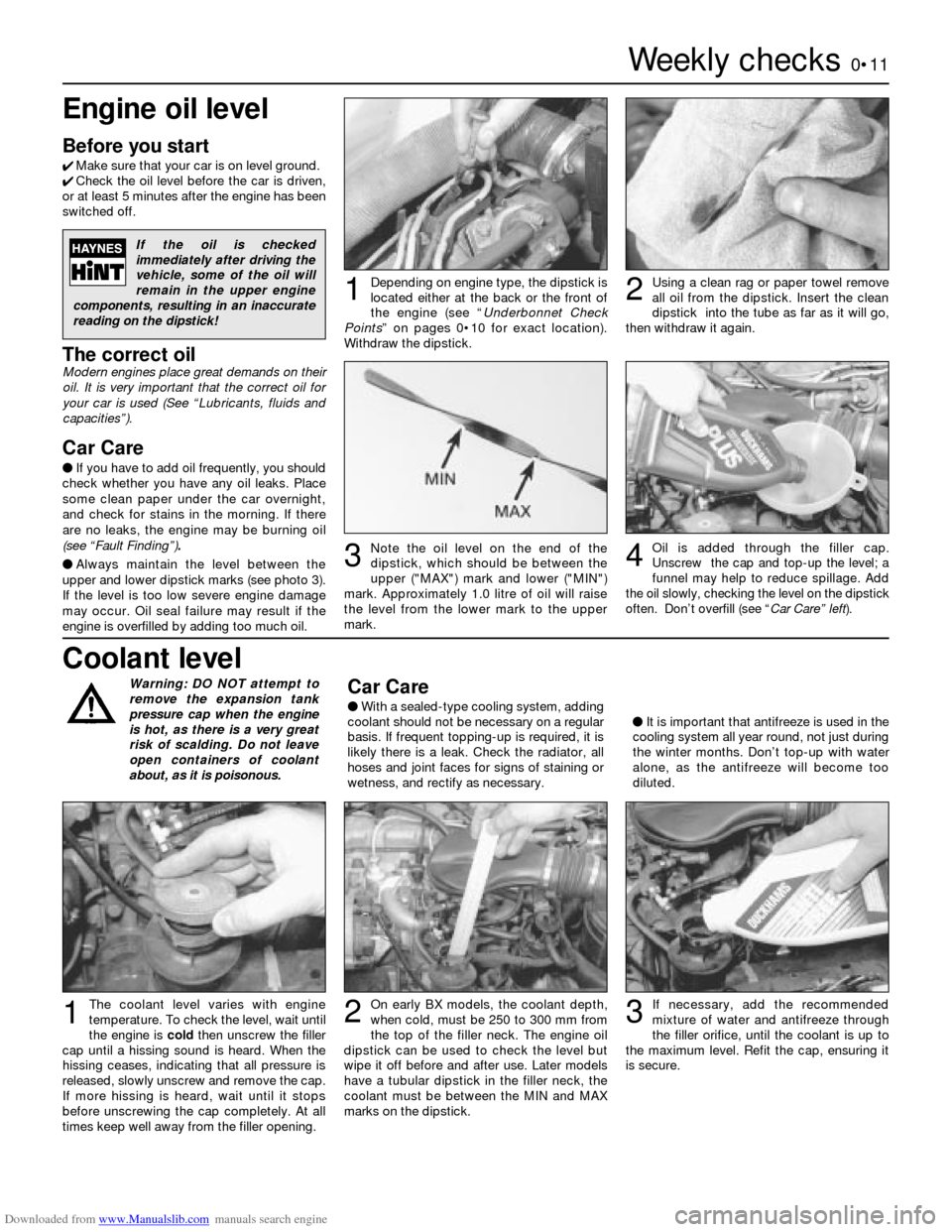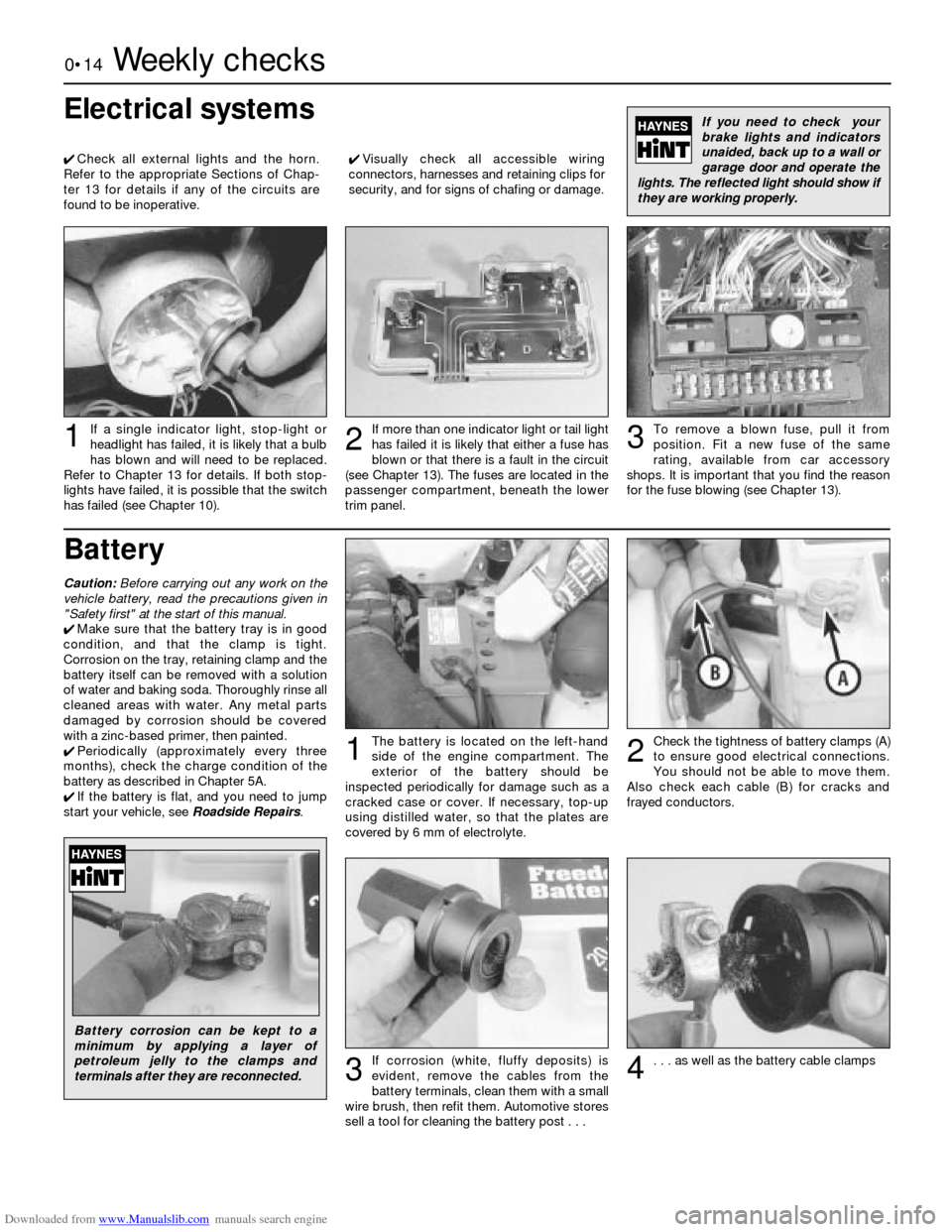stop start Citroen BX HATCHBACK 1991 2.G Workshop Manual
[x] Cancel search | Manufacturer: CITROEN, Model Year: 1991, Model line: BX HATCHBACK, Model: Citroen BX HATCHBACK 1991 2.GPages: 16, PDF Size: 0.47 MB
Page 11 of 16

Downloaded from www.Manualslib.com manuals search engine Weekly checks0•11
Engine oil level
Before you start
4Make sure that your car is on level ground.
4Check the oil level before the car is driven,
or at least 5 minutes after the engine has been
switched off.
The correct oilModern engines place great demands on their
oil. It is very important that the correct oil for
your car is used (See “Lubricants, fluids and
capacities”).
Car Care
l If you have to add oil frequently, you should
check whether you have any oil leaks. Place
some clean paper under the car overnight,
and check for stains in the morning. If there
are no leaks, the engine may be burning oil
(see “Fault Finding”).
lAlways maintain the level between the
upper and lower dipstick marks (see photo 3).
If the level is too low severe engine damage
may occur. Oil seal failure may result if the
engine is overfilled by adding too much oil.
If the oil is checked
immediately after driving the
vehicle, some of the oil will
remain in the upper engine
components, resulting in an inaccurate
reading on the dipstick!
Depending on engine type, the dipstick is
located either at the back or the front of
the engine (see “Underbonnet Check
Points” on pages 0•10 for exact location).
Withdraw the dipstick.Using a clean rag or paper towel remove
all oil from the dipstick. Insert the clean
dipstick into the tube as far as it will go,
then withdraw it again.
Note the oil level on the end of the
dipstick, which should be between the
upper ("MAX") mark and lower ("MIN")
mark. Approximately 1.0 litre of oil will raise
the level from the lower mark to the upper
mark.Oil is added through the filler cap.
Unscrew the cap and top-up the level; a
funnel may help to reduce spillage. Add
the oil slowly, checking the level on the dipstick
often. Don’t overfill (see “Car Care” left).
12
34
Warning: DO NOT attempt to
remove the expansion tank
pressure cap when the engine
is hot, as there is a very great
risk of scalding. Do not leave
open containers of coolant
about, as it is poisonous.Car Care
lWith a sealed-type cooling system, adding
coolant should not be necessary on a regular
basis. If frequent topping-up is required, it is
likely there is a leak. Check the radiator, all
hoses and joint faces for signs of staining or
wetness, and rectify as necessary.lIt is important that antifreeze is used in the
cooling system all year round, not just during
the winter months. Don’t top-up with water
alone, as the antifreeze will become too
diluted.
Coolant level
The coolant level varies with engine
temperature. To check the level, wait until
the engine is cold then unscrew the filler
cap until a hissing sound is heard. When the
hissing ceases, indicating that all pressure is
released, slowly unscrew and remove the cap.
If more hissing is heard, wait until it stops
before unscrewing the cap completely. At all
times keep well away from the filler opening.On early BX models, the coolant depth,
when cold, must be 250 to 300 mm from
the top of the filler neck. The engine oil
dipstick can be used to check the level but
wipe it off before and after use. Later models
have a tubular dipstick in the filler neck, the
coolant must be between the MIN and MAX
marks on the dipstick.If necessary, add the recommended
mixture of water and antifreeze through
the filler orifice, until the coolant is up to
the maximum level. Refit the cap, ensuring it
is secure.123
Page 14 of 16

Downloaded from www.Manualslib.com manuals search engine 0•14Weekly checks
Battery
Caution:Before carrying out any work on the
vehicle battery, read the precautions given in
"Safety first" at the start of this manual.
4Make sure that the battery tray is in good
condition, and that the clamp is tight.
Corrosion on the tray, retaining clamp and the
battery itself can be removed with a solution
of water and baking soda. Thoroughly rinse all
cleaned areas with water. Any metal parts
damaged by corrosion should be covered
with a zinc-based primer, then painted.
4Periodically (approximately every three
months), check the charge condition of the
battery as described in Chapter 5A.
4If the battery is flat, and you need to jump
start your vehicle, see Roadside Repairs.
The battery is located on the left-hand
side of the engine compartment. The
exterior of the battery should be
inspected periodically for damage such as a
cracked case or cover. If necessary, top-up
using distilled water, so that the plates are
covered by 6 mm of electrolyte.1Check the tightness of battery clamps (A)
to ensure good electrical connections.
You should not be able to move them.
Also check each cable (B) for cracks and
frayed conductors.2
Battery corrosion can be kept to a
minimum by applying a layer of
petroleum jelly to the clamps and
terminals after they are reconnected.
If corrosion (white, fluffy deposits) is
evident, remove the cables from the
battery terminals, clean them with a small
wire brush, then refit them. Automotive stores
sell a tool for cleaning the battery post . . .3. . . as well as the battery cable clamps4
Electrical systems
4Check all external lights and the horn.
Refer to the appropriate Sections of Chap-
ter 13 for details if any of the circuits are
found to be inoperative.4Visually check all accessible wiring
connectors, harnesses and retaining clips for
security, and for signs of chafing or damage.
If you need to check your
brake lights and indicators
unaided, back up to a wall or
garage door and operate the
lights. The reflected light should show if
they are working properly.
If a single indicator light, stop-light or
headlight has failed, it is likely that a bulb
has blown and will need to be replaced.
Refer to Chapter 13 for details. If both stop-
lights have failed, it is possible that the switch
has failed (see Chapter 10).If more than one indicator light or tail light
has failed it is likely that either a fuse has
blown or that there is a fault in the circuit
(see Chapter 13). The fuses are located in the
passenger compartment, beneath the lower
trim panel.
2
To remove a blown fuse, pull it from
position. Fit a new fuse of the same
rating, available from car accessory
shops. It is important that you find the reason
for the fuse blowing (see Chapter 13).31